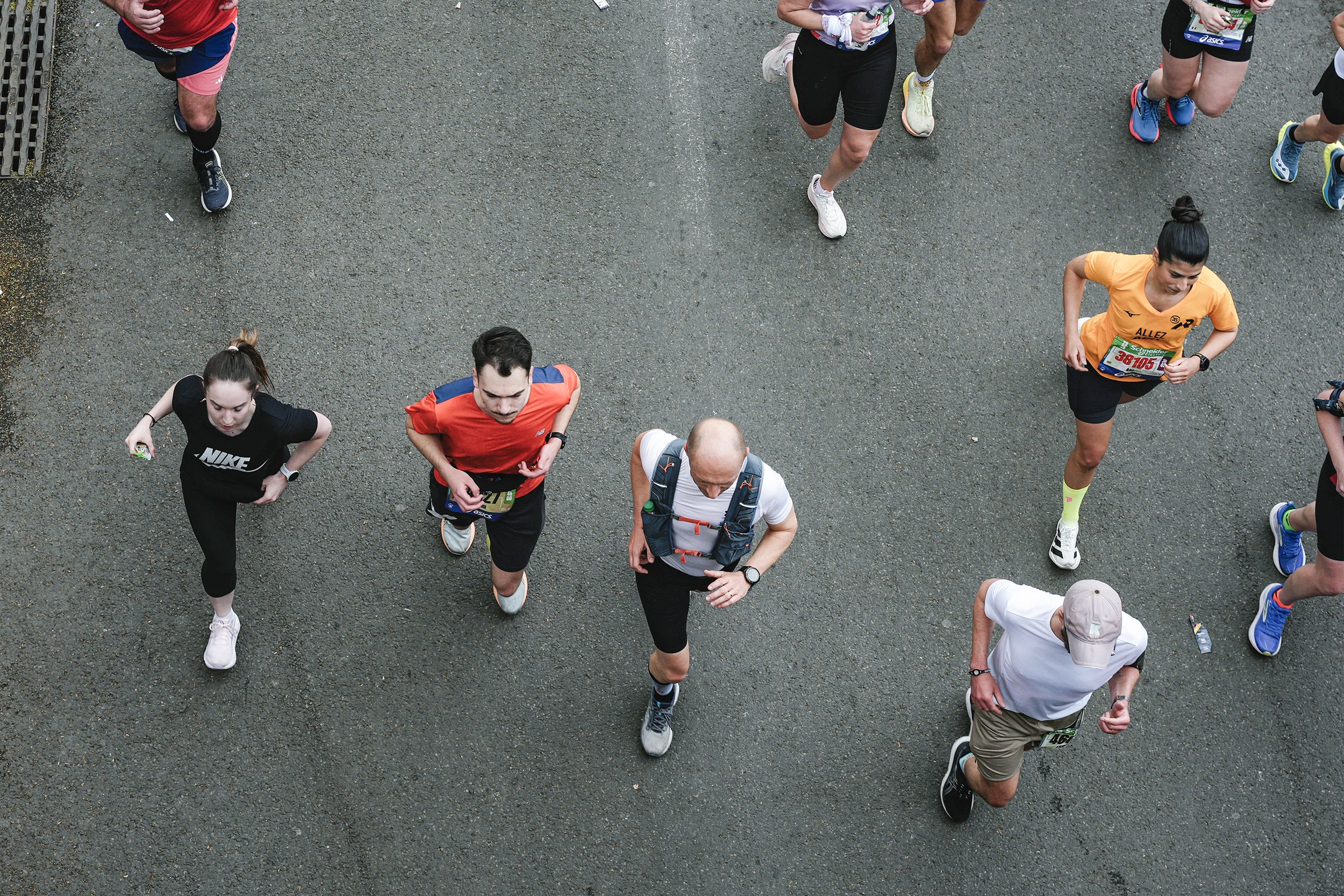Marathon: the mental preparation that makes the difference
Running a marathon means embarking on an exhilarating adventure. Between intense training, carefully measured recovery and meticulous nutrition, this race leaves a lasting mark on every runner. At times, worry and doubt make their way into this journey. Working on the mind then becomes a valuable ally to approach this legendary distance in the best possible way. Conversation with Éloïse Terrec, mental coach and former high-level racewalker.
Beginners or experienced runners alike, the marathon embodies the legendary distance par excellence, both intriguing and fascinating. Being a long-distance runner means facing pain, facing oneself, and above all facing questions. This is why training the mind is just as essential as training the body. And for good reason, this inner work is beneficial for everyone.
“Mental preparation complements all other aspects of performance,” explains Éloïse Terrec, mental trainer and former high-level race walker with six selections in international A competitions and ten among youth athletes. “It fits into a global system in which you project yourself toward your goal, toward race day, toward training, but also toward fears and apprehensions.” The goal is to benefit from support similar to that provided by a coach, to learn to ask yourself the right questions, and to discover methods to strengthen your mental resilience.

| Crossing to the Other Side of the Barrier
This path is one the athlete has walked herself. Before guiding others, she experienced firsthand the rigor and difficulty of high-level sport. After a sports-related burnout, she became deeply interested in the balance between performance and well-being. Drawing on her past as an athlete, the specialist understands better than anyone the toughness of endurance events. The 20 km race walk, one of her favorite disciplines, demands the same level of commitment as the legendary marathon distance. A former holder of several French records, the Breton native fully grasps the daily reality and questions of athletes. This gives her a valuable advantage when it comes to supporting her clients.
While mental training now holds an important place, it was long pushed into the background. For years, working on the mind was overlooked, even seen as taboo, despite being highly beneficial, and not only for sport. The various associated methods can be applied in everyday life. It is about analyzing one’s mental patterns and personal functioning. Above all, it means learning to know oneself better, explains the multiple French Elite champion in the 10,000 m and 3,000 m race walk.
| To approach competition in the best possible way
On the start line, mental work takes on its full meaning. Running 42.195 km can feel overwhelming, even intimidating. More and more runners are taking on the challenge, regardless of their level, creating a mix of excitement — and pressure. “It’s essential to acknowledge that fear and prepare for it. My role is to offer concrete tools that help the athlete realise they have the ability to succeed. In mental training, we work on psychological barriers, confidence, beliefs, and also on inner dialogue,” explains Éloïse Terrec, who turned to this profession just over two years ago.
Building an internal dialogue, practising relaxation, breathing exercises, and stress-management techniques are all ways to support athletes. Éloïse Terrec encourages runners to identify specific cues on which they can focus their attention, helping them stay centred on their race rather than on what’s happening around them.
| Hitting the Wall… at the 30 km Mark
The biggest mental blocks are usually the fear of pain, a lack of self-confidence, and the infamous anxiety about hitting the wall around the 30 km mark. Building up this moment as something terrifying creates anticipation— and therefore dread — long before reaching that part of the race. “In marathons, there’s so much hearsay that runners often adopt other people’s fears and beliefs. Yet you don’t even know if you will hit the wall at 30 km. That slump can happen earlier or later. It’s important to demystify it and help runners understand that they have everything they need to push past it,” she explains.
Her go-to strategy is a mental “switch”: a cognitive jump that takes the runner straight from kilometer 29 to kilometer 31, as if the 30th didn’t exist at all. Anchoring— using gestures, words, images, memories, or even a color — helps athletes maintain a competitive mindset. Terrec advises shifting from the mental state used in the first part of the race to another one specifically prepared for the final kilometers. Breaking the marathon into segments is often key to overcoming difficulties. “The idea is to turn that wall into an opportunity for a mental reset. You can even use the myths surrounding the marathon to your advantage.”
| Anchoring: holding on to a word, an image, or a memory

Another form of anchoring is the word—or mantra—you write on your hand, your arm, or simply keep in your head. It needs to carry personal meaning, and you have to practise repeating it. “It’s not very effective to borrow someone else’s motto and assume it will magically help you on race day. It has to work as a real anchor—something that instantly brings you back into the right mindset and lifts you up again.”
Pain is part of performance; it’s unavoidable. Acknowledging this and believing you can rise above it changes the way you face the challenge. “It’s all about how you interpret it,” she explains. But before dealing with discomfort on race day, runners first have to stay focused through the entire build-up.
The mental coach often works with athletes who struggle to stay motivated throughout this demanding preparation. After weeks and weeks of training, fatigue and monotony can set in. Consistency is key to staying the course, because long-distance runners face obstacles all along the way.
Her advice is to rely on routine as a way to reach your goal. Keeping your habits is essential so you don’t feel lost on the big day. Identifying what works in training and what fosters the right mindset helps build your own personal routine. Drawing inspiration from others can be useful, she says, but everyone has to create a system tailored to their own needs.
“You shouldn’t worry if your habits look nothing like anyone else’s. If talking or laughing is what helps you focus while others isolate themselves with their headphones, there’s absolutely nothing wrong with that.”
Éloïse Terrec, mental performance coach and former elite athlete
| When should you start training your mind?
“From the very start of your marathon training,” suggests the former French international race walker. “Some athletes come to see me fifteen days before their race. It’s not incompatible, but the impact is more limited than with a process that begins earlier. We simply can’t explore someone’s mental blocks in as much depth.”
As race day approaches, visualization becomes a powerful tool to mentally step into the event. In a challenge as colossal as the marathon, the mind counts almost as much as the legs. For the specialist, the balance is clear: 50 percent mental, 50 percent physical, and in the toughest moments, sometimes even 60 percent mental. The mind takes over “when you hit the wall,” she explains. It’s what keeps you going when, physically, “there’s nothing left.”
| The pressure of the clock, the pressure of expectations
Disappointment and setbacks are an inherent part of an athlete’s life. The weeks of training leading up to a marathon are demanding, and expectations for such a mythical distance are often sky-high. Learning to deal with frustration when things don’t go as planned is a crucial component of the process. “It can feel as if your whole world collapses when your marathon doesn’t go well, and that creates its own pressure,” explains the former international athlete.
“The most common mistake is focusing solely on performance — on the time and the final result. This happens just as much with beginners as with elite athletes. Taking a step back and remembering that all the effort invested before race day matters just as much offers a different perspective on failure. Balancing performance with the way you want to experience the event helps put things into perspective.”
Éloïse Terrec, préparatrice mentale et ex-athlète de haut niveau
Running a marathon is not just a physical feat. It is also a battle against yourself and against the pain — the very pain that makes the achievement even more meaningful. The myths and fears surrounding the distance make it as iconic as it is intimidating. When your legs begin to give out and your breathing grows heavy, there is only one force left to rely on: your mind. Learning to master it becomes an essential part of training, another building block that helps guide every runner all the way to the finish line.
➜ Discover the calendar of marathons

Emma BERT
Journaliste



